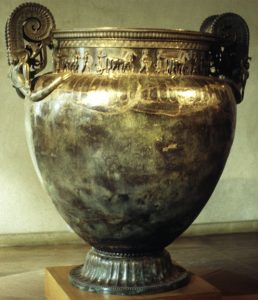Archaeology is often corrupted by the cultural norms of men and women of today. The “Princess of Vix” burial exemplifies the idea that assumptions cannot be made when examining history, especially concerning the difference between sex and constructed gender roles
The Princess Vix burial discovered in east-central France in the 1950s is a grave full of traditional ‘male’ grave goods, including a decorated wagon and jewels. However, the skeleton in the grave was a female one. Some of those who found the grave believed that the skeleton was a “transvestite priest because it was considered inconceivable that a woman could be honored in such a way” (Renfrew and Bahn 2018, 172). The very idea that the archaeologists tried to discredit the goods as being earned by a woman shows the bias occurring in archaeology when examining historical females. Archaeologists sometimes allow themselves to be blinded by differing definitions of sex and gender. Sex is defined as, “biologically determined and can be established archaeologically from skeletal remains” (Renfrew and Bahn 2018, 171), while gender is seen as a social construct that is determined by roles in society that can easily change. The archaeologists carried previous assumptions about gender into their work and could have made serious mistakes that greatly altered the interpretation of the past.

Figure 1. Princess Vix grave, displaying the female skeleton and some of the treasures found. Photograph by Claude PIARD. Creative Commons Attribution-Share Alike 4.0 International license.Wikimedia Commons
Alongside traditional male-associated artifacts in the grave, archaeologists also found a long-searched artifact: the giant Greek bronze krater from the tall tale of Herodotus. This giant bronze krater was said by the Greek historian Herodotus to have been made for a great king of Lydia (Lewis 1984). Due to the nontraditional size of this theoretical jar, historians have mocked the existence of this artifact. However, a jar matching the exact descriptions was found in the Princess of Vix’s grave. The possible existence of it alone paired with it being found so far away from Greece in a woman’s grave opens up a whole set of questions about the past. Thus, biases aren’t just causing the past to be misinterpreted, but also preventing future findings from being discovered. If the grave was interpreted differently due to biases, this infamous artifact would’ve never been examined in this capacity.

Figure 2. Giant bronze krater allegedly from the famous tale of Herodotus. It was found in the grave of Princess Vix. Picture credit: Peter Northover. Creative Commons Attribution-Share Alike 2.5 Generic license.Wikimedia Common
One finding in the discovery of the Princess Vix grave not traditionally known is that the grave led to similar discoveries of other female graves, indicating the praised role of women in the historical Celtic society, seen in the quote, “Although it is the earliest, the Vix burial is not the only high-status Celtic female burial in the area. A series of similar graves spread over the Rhine and Moselle area where women were accorded burials sometimes more splendid than many male chieftains” (Sheldon 2022). Thus, archaeologists making assumptions about the roles of women in Celtic society being similar to how our society treated women in the past is seemingly wrong.
In the end, gender and gender roles should not be assumed in any regard, especially when taking interpretation into account.
Further readings:
https://steemit.com/history/@donkeypong/who-was-the-mysterious-lady-of-vix
https://sites.uwm.edu/barnold/research/gender/
http://onlinedigeditions.com/publication/?i=104941&article_id=1009199&view=articleBrowser
References:
Renfrew, Colin, and Paul Bahn. 2018. Archaeology Essentials: Theories, Methods, and Practice. Fourth edition. Thames & Hudson. 108-140.
Sheldon, Natalie. February 16, 2022. “The Princess of Vix: Trade, Culture, and Women in Celtic Society.” History and Archaeology Online https://historyandarchaeologyonline.com/the-princess-of-vix-trade-culture-and-women-in-celtic-society/
Lewis, Paul. April 1, 1984. “A Greek Treasure in France”. The New York Times Company https://www.nytimes.com/1984/04/01/travel/a-greek-treasure-in-france.html?pagewanted=all

Given that gender is socially constructed, how do we know how gender was assigned, perceived, and performed in the past? How does this process of critical thought help us understand and differentiate sex and gender in the past?